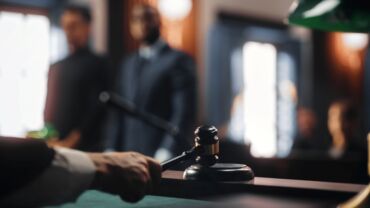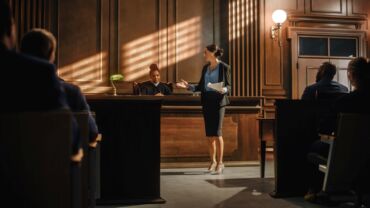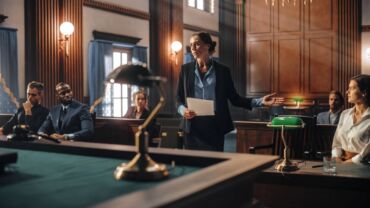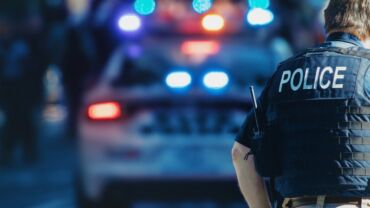The increasing use of AI-generated evidence in courts poses significant challenges for judges in determining authenticity, validity, and reliability, which highlights the need for updated legal frameworks, education, and rigorous testing of AI-detection tools to address the evolving issue of deepfakes and manipulated digital content
AI-generated evidence presents significant challenges for courts today, as judges and attorneys grapple with determining the authenticity, validity, and reliability of digital content that may have been artificially created or manipulated. The rapid advancement of generative AI (GenAI) technology has outpaced the development of reliable detection tools, and now GenAI is testing traditional evidentiary frameworks through sophisticated deepfakes and AI-altered materials that are increasingly difficult to distinguish from genuine evidence.
There are significant challenges involved with relying on automated tools to detect and authenticate evidence, says Dr. Maura R. Grossman, Research Professor at the University of Waterloo in Ontario, Canada. “We aren’t at the place right now where we can count on the reliability of the automated tools,” she explains, adding that most computer scientists consider this a tricky problem.
Defining types of AI evidence
AI-generated evidence falls into two distinct categories. One, acknowledged AI-generated evidence is openly disclosed as created or modified by AI, such as accident reconstruction videos or expert analysis tools. These applications are transparent about their AI origins and creation or modification methods, which allow courts to evaluate them as such.
Second, unacknowledged AI-generated evidence is presented as authentic and unconnected to any AI creation or manipulation when it is, in fact, AI-generated or manipulated. Such examples include deepfake videos, fabricated receipts, and manipulated photographs. This type of manipulated evidence poses significant challenges for detection and authentication in court proceedings.
The AI Policy Consortium, a joint effort by the National Center for State Courts (NVSC) and the Thomson Reuters Institute (TRI), recently published two bench cards as practical resources for judges who may face the evidentiary challenges presented by unacknowledged and acknowledged AI-generated evidence. These tools help judges make real-time decisions when confronted with potentially AI-generated materials. The bench cards provide structured questions about evidence sources, chain of custody, and potential alterations to help guide judicial evaluation.
Authenticating unacknowledged AI-generated evidence
The current legal framework for authentication of AI-generated evidence sets a fairly low bar for admissibility, according to Kelly Griffith, Senior Specialist Legal Editor at Thomson Reuters Practical Law. Generally, evidence is admissible when a party provides enough information that a reasonable jury could find the evidence is more likely than not authentic. This is often done by offering extrinsic evidence. For example, a party seeking to authenticate a voice recording may offer the testimony of a witness who is familiar with the speaker’s voice. Federal Rule of Evidence (FRE) 901(b) offers several more examples of authentication methods.
Judges usually make the authentication determination under FRE 104(a), deeming evidence authenticated if a reasonable jury could find it more likely than not genuine. Indeed, judges have the authority and responsibility to act as gatekeepers in court trials to make preliminary decisions about evidence admissibility before it goes to a jury and to assess witness credibility, which remains crucial in evaluating evidence.
However, in some circumstances, the jury must determine whether the evidence is authentic. Specifically, when a party disputes the authenticity of evidence and there is sufficient evidence for a reasonable jury to find in favor of either party, a question of fact exists. In this instance, FRE 104(b) requires the court to leave the authentication determination to the jury.
Right now, Judge Erica Yew of the Santa Clara County (Calif.) Superior Court says that the tools that judges already possess to determine authenticity are useful, but the landscape is evolving. In particular, the liar’s dividend — a concept when authentic evidence is falsely claimed to be AI-generated — is a current challenge in which the existing rules may not be sufficient.
Dr. Grossman agrees, noting that courts will need to develop strategies to address this issue, including requiring parties to provide evidence to support their claims that evidence is fake. “I think the courts will see [the liar’s dividend] sooner than the deepfakes.”
Recent cases addressing AI and evidence
Several significant court decisions have shaped the treatment of AI-generated evidence, including the State of Washington v. Puloka case, in which the court excluded AI-enhanced video evidence due to lack of reliability. In contrast, a California state court rejected a challenge to video evidence in Huang v. Tesla that centered on the vague possibility that the video could have been a deepfake.
The increasing sophistication of deepfakes, both audio and video, poses significant challenges for judges and attorneys in detecting and authenticating evidence. “GenAI generates content using two algorithms, one that creates content and one that distinguishes it from reality, creating a constant feedback loop that improves the AI’s ability to generate realistic fakes,” Dr. Grossman explains.
Key questions judges should ask
To address the challenges of AI-generated evidence, Dr. Grossman suggests that judges ask themselves three key questions:
-
-
- Is the evidence too good to be true?
- Is the original copy or device missing?
- Is there a complicated or implausible explanation for its unavailability or disappearance?
-
In addition, Judge Yew advises judges to consider the credibility of the witness and order in-person appearances when necessary. And Dr. Grossman says that substantial scientific work is necessary before courts should trust AI tools.
Megan Carpenter, Dean and Professor of Law at the University of New Hampshire’s Franklin Pierce School of Law, is pushing for the creation of a comprehensive framework for the evaluation and ongoing development of AI-powered legal tools. “Legal AI tools should undergo the same sort of rigorous training and testing that humans undergo to do the same kind of work,” Carpenter says, adding that this approach would ensure reliability while adapting to evolving technology.
Check out the next webinar, AI-Assisted Translation in the Courts: Exploring Opportunities and Navigating Risks, in the NCSC-TRI AI Policy series here







